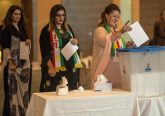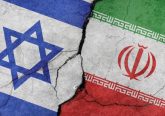 After long years of silence and quiescence, the Non-Aligned Movement gained momentum in the debate about global governance and the management of alternative strategies of engagement with the world of international affairs.
After long years of silence and quiescence, the Non-Aligned Movement gained momentum in the debate about global governance and the management of alternative strategies of engagement with the world of international affairs.
The setting was an unusual one per se, suggesting that the 16th gathering of the NAM was likely to be of a different nature. Indeed, Tehran, during the heated summer of 2012, seemed to be one of the less aligned capitals of the world, for a number of issues, widely debated in political science circles as well as among foreign policy decision-makers. Crippling sanctions, shadow negotiations and an on-going regional conflict in the Middle East, with several branches developing in Syria, Lebanon, Bahrain and perhaps Yemen, have put Tehran on the faultline of many quakes.
Not surprisingly, the conference was set up amidst many external challenges as well as internal problems.
In primis, the attempt by the Obama and Netanyahu administrations to prevent the participation of major international and regional players, in a bid to further isolate Tehran and strengthen the perception of separation from the rest of the world to the Iranian leadership, and the Iranian people. UN Secretary General Ban Ki Moon was repeatedly invited not to take part in the NAM gathering, because of Iran’s latest declaration against Israel and the stalemate in the nuclear negotiations. Likewise, American policy-makers sought to convince the newly elected Egyptian President Muhammad Morsi not to attend what was seen as a clearly anti-American event.
Both of them refused to give up to these pressures and eventually entered the diplomatic scene along with other countries’ high representatives, including the Prime Minister of India Manmohan Singh, North Korean Foreign Minister Paek Nam Sun, Palestinian President Mahmoud Abbas and many others.
At a domestic level, the Iranian authorities indicted a week-long holiday in the capital Tehran, to ease traffic pressures and possible security problems. Those who opted to stay in Tehran, witnessed a massive deployment of security forces, particularly in the northern part of the city where the Conference Centre is located. The sentiment among Tehrani people was generally one of indifference for the political scope of the event, and estrangement from the state propaganda. This could be a sign of disaffection towards the magnitude of the government’s expenditure for the event, but also a hint to the widening gap between people and authorities, as repeatedly suggested by leading clerical figures in the country (Rafsanjani reported by Sharq, 24/08/2012)). For a couple of weeks the NAM Summit became the scapegoat for people’s sorrows; previously people complained about the price of chickens and international sanctions.
The Iranian leadership stressed two major discourses during the 5-days meetings. First, it called for a general opposition to unilateral sanctions, an alternative wording to refer to US-led sanctions against Iran. Then, it laid the ground for a non-aligned resolution of the Syrian conflict. Both tracks are at the centre of the current international confrontation in the Middle East and could be the trigger for a reconfiguration of the region in the 21st century, under re-imagined auspices.

The outcome of the Iranian strategy can be seen as twofold. On the one hand, Iran succeeded in obtaining the support of the NAM countries to its nuclear programmes, despite the contemporaneous publication of the AIEA report on the Iranian nuclear programme (with increasing concerns over Tehran cooperation with the Agency). On the other hand, the attack by the Egyptian president against the al-Assad regime and Egypt’s support for the rebel cause, aroused discontent and perplexities among the Iranian hosts. Thus, Mursi rebalanced his position in the international context, after Western and Israeli fears of a steadfast rapprochement between Tehran and Cairo, on the eve of his visit. The visit cum speech had also important domestic repercussions for the Egyptian President, notably sending a message to his people to say that Egypt is ready to pursue an independent foreign policy (beyond the Iran-US dichotomy).
Meanwhile, Iran won the NAM support for its nuclear programme and against international sanctions (as remarked in the final document of the summit), but failed to gather enough consent on Syria. In particular the bold and direct rejection by Mursi, has narrowed the chances of a peaceful transition in Damascus, other than being a public relation setback for the Islamic Republic. If one has to count the pros and cons of the Summit, it is hardily deniable that it represented a significant step forward for Tehran, during a political cycle where economic and political isolation risked endangering the self-portrayal of Tehran as a potent and powerful player in the regional and international arena. Another point which could be counted in Iran’s favour is Venezuela’s election as the next NAM chair in 2015; of course, only if Chavez succeeds in winning the coming elections and his health conditions do not worsen.
Yet, the main question, also among commentators is What is the true value and role of the Non-Aligned Movement in the current international arena?
The answer is not an easy one and requires both an historical sensibility and political imagination outside the conventional ‘Big Powers’ framework.
After the fall of the Soviet Union, the world witnessed the American unilateral momentum; its narrative and logics are visible during the Obama administration, even though its apex is to be found in the 2003 invasion of Iraq. In that context, the role of the NAM has been largely symbolic and ceremonial, a relict of a past ideal. Nevertheless during the last decade, parallel developments in the world of international relations, like the empowerment of regional super-powers (i.e. Brazil, India) and the new international super-power (China), envisioned a tendency towards a multi-polar system, where unilateralism dominates over collective decision-making. (The latter can be regarded as an ideal system of global governance, as well as a dystopia for national democracies).
The reappearance of the NAM in this framework of relations could bring back in the global arena of diplomacy the large bulk of developing countries, which are now mainly hostage of bilateral relations with super-powers. It does not mean that there will be a sudden impact on the political balance, but it might have implications on their influence, both symbolic and real.
If the ‘multipolar moment’ develops simultaneously with a slow, but steady decline of American global power, the NAM is likely to play a non-marginal role. The NAM could in fact fill the empty spaces of power in an increasingly conflictual and antonymic international system, providing voice for alternative diplomatic tracks and pressuring world powers for the establishment of new global governance practices in the 21st century.
The Islamic Republic despite its formal marginality during the last decades and the fierce anti-Iranian propaganda in US and European media, has pursued a veritable non-aligned foreign policy, enshrined in the revolutionary slogan “neither West, nor East…”. The negative effects of this strategy has been evident both in Iranian domestic politics, with high inflation and partial economic and cultural isolation, and external relations, with Iranian foreign-policy makers constantly attempting to set up alternative tracks of inter-state relations.
Could the Iranian NAM leadership provide a new alignment for the theatre of the non-aligned movement, with the result of an effective diplomatic performance? Or will it end up being just another anti-Western gathering in an era of globalised culture and economy?
The answer is likely to depend on the outcome of the many battlefields of the international arena, in which Iran is an active player.
Maziyar Ghiabi is a postgraduate student at St Antony’s College, University of Oxford.








No Comment